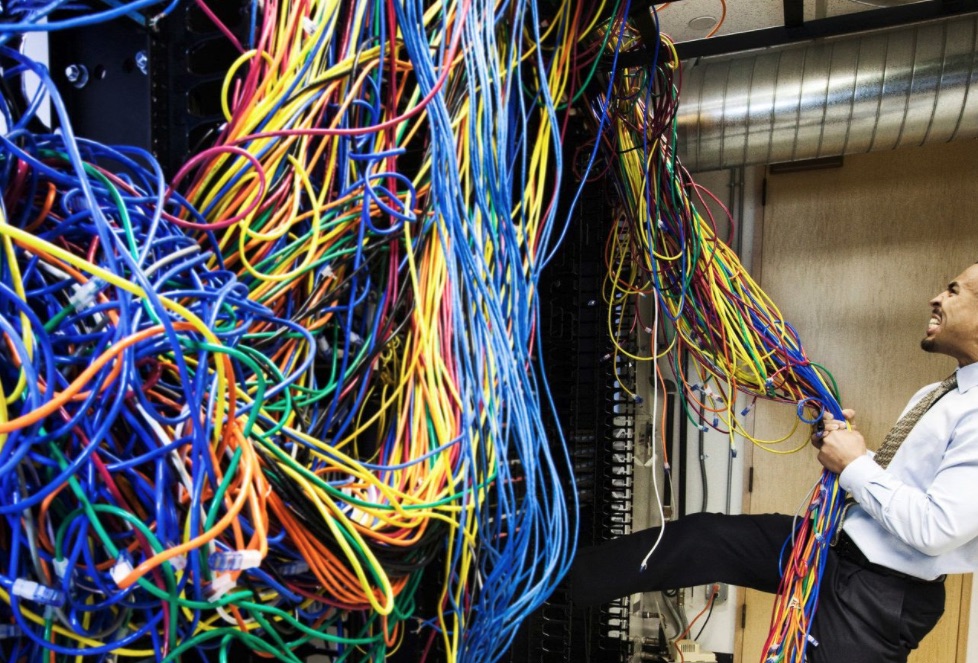Warning: extremely interesting and captivating blog post ahead.
I posed a question to some nerdy computery mates about the use of Ethernet over Powerlines, and one of them made a comment “I’ve always been confused about the complexity of your home network setup”… to which I thought “It’s not THAT complicated?!”.
My computer, the linux server, label printer, and laser printer all connect into this little 5-port switch here, and that connects into the back of the mesh wifi disc (with the blue light).

(The linux server does a couple of jobs – it runs our Plex server, for serving video content to the TV, and also serving my 150gb+ music collection to the Sonos, and if I’m doing any software projects I’ve also got Docker running on it and a variety of containers – so it’s also a handy environment for me to play with rudimentary container setup and other linuxy stuff that I need to know about but don’t have a safe playground for work)
The mesh connects to the other mesh discs, depending on which has the best signal. One’s at the top of the stairs.

That’s got a network cable that runs up the inside of the airing cupboard…

…into the roof, then across the roofspace and down through Liz’s wardrobe…

…and into what I like to call “The Line to The Switch In The Wardrobe”.

A cable also comes out of that (on the right of the picture), then runs across under a shelf over to my side of the wardrobe…

…and then down through the floor…

…through the loungeroom ceiling and down the side of the chimney (that hole in the ceiling was there when we moved in)…

…into the TV cupboard – where it joins another switch.

This plugs the TV, the Sonos, the Roku, the MiHome lighting control box, and the other mesh Wifi disc.

So, the only remaining linkage goes from the Switch In The Wardrobe, down through the floor on Liz’ side, and through the lounge ceiling…

…coming down the other side of the chimney, and then plugging into the router.

The router is the Linksys EA6900 there in the middle, with its antennae cut off. This plugs into the Virgin fibre router, and that connects through the Virgin coax socket on the left into The Outside World.
I stopped using broadband-providers’ routers for doing DHCP, because they’re just ALL SO SHIT, and I got really tired of having to set everything up again every time we changed providers (which you more or less need to do every year because of the stupid way the UK’s customer acquisition-led marketing mentality works). And because the company-provided ones never let you set things up the way you want (e.g. some let you set your own IP ranges, some fix you to 192.168.1.x, some to 192.168.0.x… which means a total reconfigure EVERY time). SO, I dug out an old Linksys router I had lying around (which I’d stopped using, because it had a thunderingly shit vendor firmware running on it), and sacrificed a couple of days of spare time to get FreshTomato working!

(and THAT only took finding & downloading 3 older vendor firmwares, because one wouldn’t allow uploads over a certain size, then we needed a step upgrade, in order to finally get to the version you needed in order to start sideloading then flashing the custom one – THEN there was downloading the image of the kernel thing, the downloading a windows emulator for the mac in order to start up the kernel image editor, so I could poke in the MAC addresses of the router, then flash that across, and THEN install the damn custom software… Oh – and having to download 8gb of Xcode for the OS X laptop so that the windows emulator would work…)
But it is lovely, and does all kinds of wonderful things.

And THEN a week after getting that working I could just switch broadband providers and plug their stupid crap router into my lovely one, and our network continued working seamlessly.
So the *reason* for the conversation at the top of this post was because I’d found some Netgear PL1200 Powerline adapters, and I wondered whether it’d be advantageous to use that to create a “hardwire” connection (by sending the LAN signals across the electrical wiring) from the office into the main router, rather than using the mesh wifi to link as I do now.

It seemed plausible – hardwires are always faster, right? And the PL1200s claimed to be able to deliver up to 1200 Mbps. WELL… a little bit of LAN speed test action, writing from my laptop to a shared folder on the linux box revealed the following…


Turns out the mesh kicked its arse!
But anyway – all that aside, it’s not THAT complicated, is it?

(the EoPL connection would have created a hard link from the office switch into the EA6900, which in my mind could only be a good thing, meaning every ethernet-networked device in the house was physically connected… but the data proved otherwise!)




